Abstract
The current agri-food supply chain is affected by different problems such as food loss and waste generation along the supply chain, and the circular economy offers a possibility to enhance and optimize the production and consumption to seek to a sustainable paradigm. The circular economy can be a winning approach to intervene and moderate the impacts generated in the agri-food sector, proposing actions and solutions to readmit wastes and by-products in the productive chain. The aim of this work was to perform a literature review coupled with a bibliometric analysis, using VOSviewer software, on the circular economy model in the agri-food sector, with particular relevance to the reuse and valorisation of wastes and by-products. Results showed that the topic is of particular relevance in the scientific community, and the concept is continuously evolving. Europe plays a leading role in the research, thanks to the involvement of the Member States, policy makers and stakeholders. Nevertheless, some aspects such as the development of a new economic circular model and some limitations of the current policies deserve further investigation.
1. Introduction
The current agri-food supply chain is affected by different problems of economic, social and environmental natures, making it unsustainable. Among the possible solutions, the circular economy offers tools to enhance and optimize the production and consumption to seek to a sustainable paradigm [1]. Over the last decade, growing attention has been paid to this new concept with the aim to provide an alternative to the dominant linear economic model [2,3]. Indeed, the circular economy is a model of production and consumption that involves sharing, leasing, reusing, repairing, refurbishing and recycling existing materials and products as long as possible, extending the life cycle of products and reducing waste to a minimum [4]. The circular economy concept is of great interest as a way to implement the sustainable development [5]. It is a concept currently promoted by the European Union [6,7] to enhance competitiveness, protecting businesses against scarceness of resources and helping to create new opportunities and innovative markets [8].
In December 2015, the Commission adopted a Circular Economy Action Plan to give a new boost to jobs, growth and investment and to develop a carbon neutral, resource-efficient and competitive economy. The Action Plan sets out a policy framework that builds on and integrates existing policies and legal instruments. The Plan proposes various new initiatives devoted to favouring the conversion from a linear to a circular model, in line with the 2030 Agenda of the United Nations for the achievement of the Sustainable Development Goals (SDGs), in particular SDG 12, “Sustainable Consumption and Production”. Due to the successful implementation of the first document and the achievement of all the targeted actions, in March 2020 a new version of the Circular Economy Action Plan was released [9,10].
Food waste is one of the targeted areas in the Circular Economy Action Plan [11]. Food waste is an issue of importance at global level, directly linked with environmental, economic and social impacts [12,13]. According to Eurostat [14], in 2018, the total waste generated in the European Union by all economic activities and households amounted to 2 337 million tonnes; agriculture, forestry and fishing produced 19.5 million tonnes (0.9%). Food is wasted through the entire value chain, from initial agricultural production down to final household consumption [15]. There is quite some confusion when referring to “food waste” in general, as there is a difference between food loss and food waste. Food losses refer to a decrease in food quantity or quality in the early stages of the food supply chain, reducing the amount of food suitable for the human consumption. Food loss includes unavoidable food supply chain wastes from farm to fork. Food wastes, on the other hand, often refer to later stages of the supply chain, such as retail and households [16]. According to this definition, the amount of food losses generated by the primary production and processing in Europe in 2016 was 26 million tonnes, while the food wastes accounted for nearly 61 million tonnes, 77% of which comes from households and the remaining 33% from the wholesale, retail and food service sectors [12]. During harvesting and transformation of the raw materials, from a semantic point of view, we are still referring to food loss; nevertheless, the scientific literature generally considers the discarded parts as “wastes” and “by-products”. From the Waste Framework Directive [17], “waste” means any substance or object which the holder discards or intends or is required to discard, while “by-product” is a substance resulting from a production process, where the primary aim is not the production of that substance. Consequently, a by-product shall not be considered as waste. The term “bio-waste” includes biodegradable waste from gardens and parks, food and kitchen waste from households, offices, restaurants, wholesale, canteens, caterers and retail premises, as well as comparable waste from food processing plants.
Considering the environmental, economic and social implications of food waste, the first step towards a more sustainable resolution is to adopt a sustainable production and consumption approach, without focusing only on the final part of the supply chain [18]. The circular economy can be a winning approach to intervene and moderate the impacts generated in the agri-food sector, proposing actions and solutions to readmit wastes and by-products in the productive chain [19]. However, it will be limited to consider circular economy only as an alternative approach to a more efficient way of waste management. It requires a broader and comprehensive look at the design of radically alternative solutions, over the entire life cycle of any process as well as at the interaction between the process and the environment and the economy in which it is embedded [3]. In literature, it is possible to find studies dealing with the recovery of high-added value components [20,21,22,23,24], the use of waste for insects rearing [25,26], the reuse of wastewaters in agriculture [27,28] and the conversion of biomasses into energy [29,30,31]. Nevertheless, scientific studies with a holistic approach on the possible application of a circular model in agriculture and the food supply chain are still not diffused. Therefore, this paper offers a review on the relationship between the circular economy and the agri-food sector, with a focus on the treatment and valorisation of food wastes and by-products, by identifying the most productive countries, the most cited works, the journals and sectors on which the publications are addressed. At the same time, the topics around which the research rotates, the relationship among the countries and the authors are exploited using VOSviewer software through a bibliometric analysis. The paper is structured as follows: Section 2 presents the methodology, and the main results are discussed in Section 3. Then, Section 4 discusses the results, and finally, Section 5 presents our conclusions.
2. Materials and Methods
2.1. Creation of the Database
The research was carried out in two different databases, Scopus and Web of Science (WoS), to expand the range of eligible documents. First, an appropriate sequence of keywords, based on the research objectives, was carefully selected. The search was performed setting up “Article title, Abstract, Keywords” field in Scopus, and “Topic” field in WoS, because if one of the chosen keywords of the string is not present in the title nor the abstract or the keywords, the article is not relevant for the purpose of the research.
The first attempts included only {circular economy} AND ({food waste} OR “by-product”). The result was too wide because of the correlation between circular economy and by-product without specifying the relationship with “food”, led to the inclusion also of papers on concrete and the construction sector (out of context). In a second attempt, the string was changed into ({circular economy} AND “food” AND (“waste” OR “by-product”)); in this way, the number of results decreased. To include both the agricultural and agri-food sector in the research, the final string of words used in the research was {circular economy} AND “food” AND (“waste” OR “by-product”) AND “agri*”. Table 1 shows the process of improving the research string based on the research question. The last string allowed to deal with a manageable number of studies focused on the topic of interest.

Table 1.
Development of the search string used in Scopus and WoS database.
The papers were collected on 18 February 2021. Data collection was performed for each database separately but using the same methodological criteria [32]. The two results were considered together performing the productivity measurement and the bibliometric analysis.
2.2. Selection of Papers and Method of Analysis
This step is necessary to keep only the papers relevant for the analysis. In line with Do et al. [33], the following principles were used to skim the list of documents:
- Including only articles and reviews written in English: excluding 43 documents in Scopus and 16 in WoS;
- Including only the documents where the full text was available to read: excluding 16 articles from Scopus and 14 from WoS;
- Removal of overlaps between Scopus and WoS: a total of 109 overlapping documents was individuated.
- Including only papers where title and abstract were relevant to the research question: 36 papers from Scopus and 89 papers from WoS.
To avoid subjective decisions, three authors performed the screening of literature [34]. Since this moment, the two databases have been considered as one. The final database was composed of 125 documents (15 March 2021). For the analysis of the database obtained, productivity was measured [34] according to the evolutions of publications over the years, the main countries involved in the research on the topic, the distribution of articles by journal, the research areas most involved and the papers most cited. Then, a bibliometric analysis was performed using VOSViewer (1.6.16). A bibliometric analysis can highlight several interesting information available in the literature, supporting a structured review [35]. The bibliometric mapping approach is data-driven and relies heavily on computer algorithms and visualization techniques. VOSviewer is one of the most popular software used by researchers to do so. It allows users to create, visualise and explore maps based on network data [36]. The map is a visual representation of the topic by showing the relationship between items (keywords, authors, papers, countries) in the field. The maps normally guide the analysis, but the expertise in the field is still necessary for a proper interpretation of them, to understand each cluster and give sense to the data [37]. Co-occurrence, co-authorship, citation, bibliographic coupling and co-citation have been explored.
3. Results
In the following section, the main results obtained from the productivity and bibliometric analysis are examined.
3.1. Measurement of Productivity
The distribution of papers over the years, the most active countries, the journals most involved, the areas in which the research is currently focused and the most important papers are shown in this section.
3.1.1. Years of Publication
Figure 1 shows the distribution of papers from 2014 to 2021. A growing trend is recognized by analysing the number of publications per year.
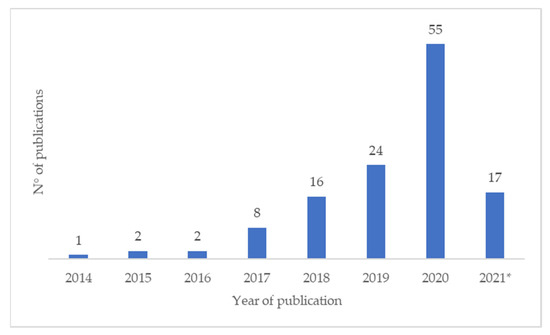
Figure 1.
Distribution of publications over time. * Papers published as of March 2021.
The first recorded study (in the WoS database) is by Mirabella et al. (2014), who focused on the possible use of food wastes of different origins (fruit, vegetable, dairy products, meat). Starting from 2017, the topic began to gain attention from the scientific community in a consistent way, and the trend continues to increase nowadays (+588% between 2017 and 2020). The scientific production could have been stimulated by the Circular Economy Action Plan, adopted by the European Union in December 2015. In particular, on 26 January 2017, the European Commission released a report on the implementation of the Plan with the aim to present a complete overview of the actions delivered in the implementation of the EU Action Plan since its adoption and to introduce key deliverables for 2017 [38].
3.1.2. Most Productive Countries
Figure 2 shows the countries with the higher number of publications; in particular, Italy is the most productive country (34 publications), followed by Spain (23) and the UK (13). China (as Brazil) has only eight documents. China developed a circular economy-based strategy in 2002, but the concept of the circular economy has gained a rising attention from governments and researchers since the Circular Economy Promotion Law of People’s Republic of China came into force in 2009 [39]. Europe approved the first Action Plan in 2015. While China promotes CE as a top-down national political approach, the EU implemented it as a tool to design bottom-up environmental and waste management policies [3]. Even if the approaches are different and the time span delayed, the EU is currently the leader contributor to the research on CE and agri-food.
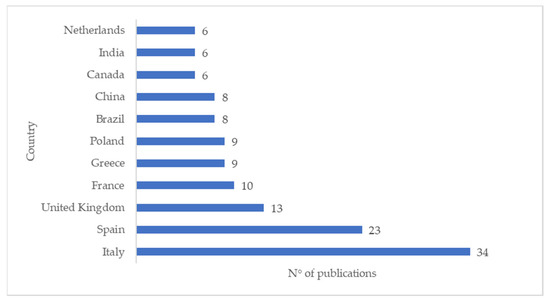
Figure 2.
Most productive countries.
3.1.3. Most Publishing Sources
Figure 3 shows the top 10 journals with the highest number of publications, publishing on circular economy in the agri-food sector. The Journal of Cleaner Production is the most active (10 documents), followed by Sustainability (8 documents) and Resource Conservation and Recycling (7 documents). The top 10 journals represent the 43% of the total database, meaning that the remaining 57% presents two publications or less. It is remarkable that the focus of these journals is related to the different aspects of sustainability (environmental, social, economic, cultural).
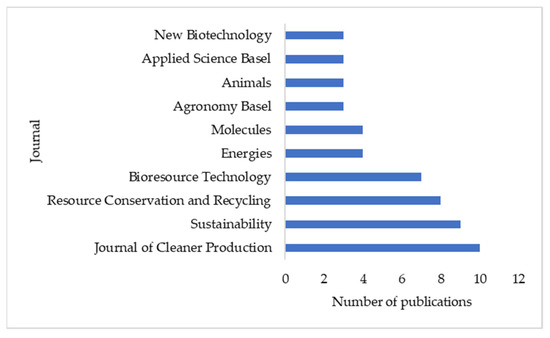
Figure 3.
Most publishing journals.
Even if the Journal of Cleaner production is the source where most of the papers were published in the temporary arc considered, it is not the most active in absolute terms: Figure 4 shows the trend of publication over the years in different journals (namely, the first four on the list with more than seven articles). Sustainability and Bioresource Technology published more (five documents each) in 2020 than the Journal of Cleaner Production (four documents).
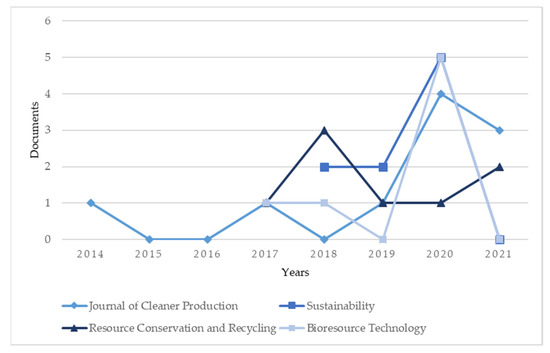
Figure 4.
Distribution over time of publications for the journals with the higher production.
3.1.4. Research Areas
The most investigated scientific fields were assessed. Table 2 shows the top three research areas (Research areas are macro categories under which the different topics fall. Broadly, a research area is what a research topic is placed into but is much broader than the scope of the topic. On the other hand, a research topic would be a specific question, hypothesis or problem wished to be investigated and answered that is under the scope of the research area. A research topic is a subject or issue that a researcher is interested in when conducting research.). It is remarkable that “Agriculture”, which is the focus of the research, is only after “Environmental Science” and, in particular, “Engineering”. This result underlines the fact that the combined effort of the scientific community is devoted to deeply exploiting the environmental and mechanical aspects rather than focusing on agricultural practices.

Table 2.
Most exploited research areas.
The European Commission is particularly concerned about the agri-food sector, that represents a critical sector in Europe. The cause relies on the fact that over the past 50 years, the agricultural industry has become more resource-intensive and unsustainable from the environmental point of view. Therefore, this sector plays a key role to foster the sustainability of the food system [40].
3.1.5. Most Cited Papers
Table 3 shows the most important papers on the relationship between the circular economy, the agri-food sector and food waste/by-products. To measure this element, the number of citations that these publications received was considered [32]. A citation analysis is crucial to detect the most prominent documents in the area of research [34]. If a paper is cited several times, it means that it is considered a milestone in a particular field, and these articles allowed us to determine the most relevant topics in our field of interest

Table 3.
Most important papers according to the number of citations received in SCOPUS e WoS database.
The most notable topic is the use of waste and wastewater for different purposes, namely, mushroom cultivation, microalgae cultivation, fertilizers, etc. The most cited article is “Current options for the valorisation of food manufacturing: a review” by Mirabella et al. (2014). The aim of the paper is to focus on the use of food waste coming from different manufacturing chains (fruit and vegetable, meat, dairy products, miscellaneous) converting them into valuable resources for the production of new products [41]. It is also the sole paper that directly addresses the relationship between food waste and their valorisation, even if the concept of circular economy is only mentioned and it is not the key point of the discussion.
Christou et al. propose a state of the art of the fate of antibiotics removed from reclaimed wastewaters for agricultural purposes [42].
The work of Nizami et al. examines the potential of waste biorefineries in developing countries as a solution to the current waste disposal issues and to produce fuels, power, heat, value-added materials and chemicals in order to enable circular economies. They present also the challenges and barriers [43].
Microalgae are treated by Stiles et al. as well as by Markou et al.; while the first author studies the potential of cultivating microalgae on digestate as a feedstock, using the resultant microalgal biomass to produce livestock feed, biofuel or for higher-value bio-products [44], the second exploits the possible contaminants found in agro-industrial wastes and wastewater to deeply understand the factors affecting their use as a substrate for the cultivation of microalgae and duckweeds [45].
Maina et al. present an overview of the waste management for municipal solid waste and food supply chain waste also considering the latest advances in the bioconversion processes [46].
In their review, Grimm et al. discuss the possibilities in mushroom cultivation by using the spent mushroom substrate, a common waste from a previous cultivation of mushrooms, as the main substrate for new productions, animal feed, to promote health of animals and to produce packaging and construction materials, biofuels and enzymes [47].
Hamelin et al. perform the first study which comprehensively geo-localizes a broad variety of residual biomass streams (pruning, straw, manure, agro-industrial waste, etc.) for the whole of EU, to quantify the maximum potential for a variety of key residual biomass streams in the EU-27 (plus Switzerland) and geo-localize it at the NUTS-3 region level [48].
The study by Riding et al. address the scientific, regulatory and socioeconomic barriers to the use of the nutrient waste streams from biomass thermal conversion and anaerobic digestion as sustainable soil amendments for use in place of traditional fertilisers [49].
Pagotto and Halog’s article assesses the Australian agri-food industry by evaluating the economic and environmental efficiency performance of the subsectors, underlying the necessity to move towards a circular model instead remaining into the traditional linear system [50].
Lastly, Zucchella and Previtali propose an economic model, developing a business model tailored on agriculture based on circularity principles [51]. It is remarkable that this publication is the only one in the list published in an economic journal (“Business Strategy and the Environment”) even if the focus of the search is “circular economy”. Reviews represent most of the literature found in Table 3.
3.2. Bibliometric Analysis
In this section, the results of the bibliometric analysis using VOSviewer software are shown. For the purpose of the study, only the most relevant results will be considered.
3.2.1. Co-Occurrence
Co-occurrence analyses the most frequent keywords, consequently providing a deeper insight into the main topics and research trends. In Figure 5, the dimension of the circles surrounding the word represents the number of times the keyword appears in the documents and the relatedness is connected to the number of documents where these words appear together. The lines represent the link between them. The terms occurring at least three times were considered. A total of 72 words were identified and 7 clusters were formed. The results showed in the figures represent only the networked items.
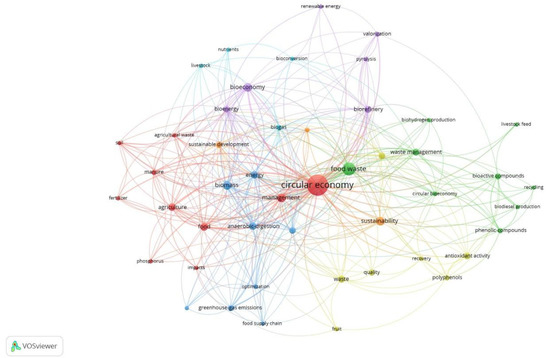
Figure 5.
Network visualisation of the co-occurrence items (Minimum number of occurrences of a keyword: 3).
The node of the network is represented by “circular economy”. Considering all keywords, the items (objects belonging to the network) with more occurrences, beyond “circular economy” (74) and “food waste” (27), are “biomass” (13), “sustainability” (13), “food” (10), “agriculture” (9), anaerobic-digestion” (9), “bioenergy” (7) and “life-cycle assessment” (7). This shows that the concept of the circular economy in the agri-food sector is strictly connected with the sustainable development of the industry and the environmental aspect. The renewable energy generation and energy from scraps and wastes remain the main areas of research, while the recovery of bioactive compounds from food industry by-products is not fully investigated by the scientific community.
Figure 6 shows the Overlay visualisation of the co-occurrence network. The overlay visualization is a display of items identical to the network visualization. The only exception is that the items are coloured differently, based on the different “scores” that these items have [36]. In this case, the score is represented by the average publication year. The darker colours (blue) represent the first topics to be studied. As the colours become brighter (greenish, yellow), the newest topics of interest from the scientific community are highlighted.
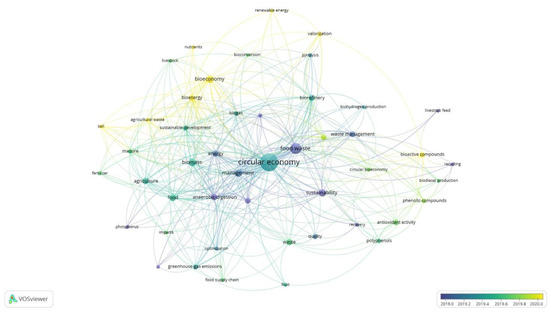
Figure 6.
Overlay network visualisation for the co-occurrence. The darker colour represents the topics studied before, and the brighter colour represents the newest topics.
Regarding the recovery and reuse of wastes and by-products of the agri-food supply chain, the interest of the scientific community was firstly devoted to the energy sector: “recycling”, “anaerobic-digestion”, “energy” and “sustainability” are the keywords with the darker label. Currently, the research is mostly dedicated to the concept of “bioeconomy”, the preservation of the “soil” and the identification, recovery and valorisation of “bioactive compounds”.
3.2.2. Co-Authorship
Figure 7 shows the network visualisation map for the co-authorship, related to the number of documents of a country. In this representation, the dimension of the circle represents the number of documents produced, and the closeness between labels represents the relatedness for the number of co-authored documents. The countries that have published at least one document were considered. A total of 49 countries were identified. The results showed in the figures represent only the networked items.
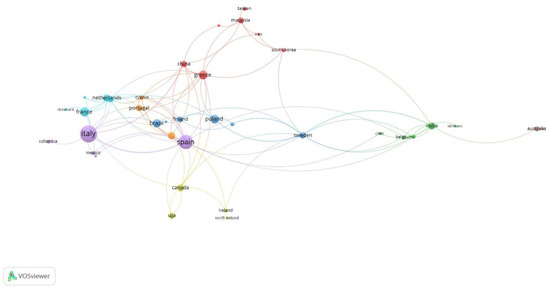
Figure 7.
Network visualization of the co-authorship items by countries (Minimum number of documents of a country: 1).
The co-authorship parameter indicates the partnership between countries in the development of the articles. Italy published the highest number of articles (34), in partnership with China and Spain. Authors from Australia produced only three articles and cooperated only with India. This analysis reveals the international cooperation and affiliation between authors from different nationalities.
Figure 8 shows the Overlay visualisation of the countries’ co-authorship network. In this representation, the score of the item is represented by the average publication year of the documents. The darker colours (blue) represent the first to be published. A brighter colour (greenish, yellow) means that the country started to publish later.
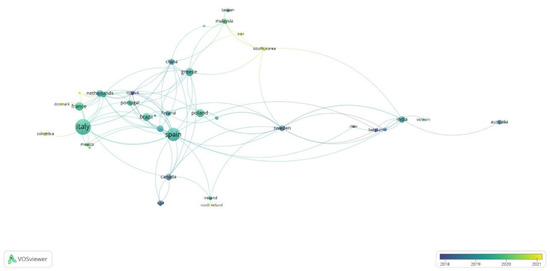
Figure 8.
Overlay network visualisation for the co-authorship. The darker colour represents the countries who started to publish before, the brighter colour represents the latest countries who started to publish.
The first countries to begin studying the relationship between the circular economy and the agri-food chain were the Nordic European countries (Sweden, Belgium, The Netherlands). The most productive countries, such as Italy and Spain, entered the context of scientific research only afterwards. Last in the timeline were Asian countries such as South Korea and Iran.
3.2.3. Citation
Figure 9 shows the citation network created by VOSviewer for the publications (a), journals (b), authors (c) and countries (d). The dimension of the circle represents the number of citations for the first network and the number of documents for the others. The closeness specifies the number of times they cite each other. Documents with at least one citation were considered; sources, authors and countries with at least one document were included. The results showed in the figures represent only the networked items.
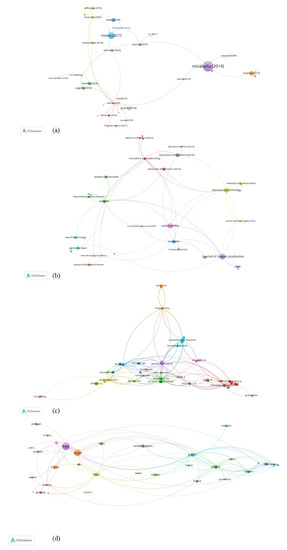
Figure 9.
Citation network visualisation map for (a) document (Minimum number of citations of a document: 1), (b) source (Minimum number of documents of a source: 1), (c) authors (Minimum number of documents of an author: 1) and (d) countries (Minimum number of documents of a country: 1).
The Journal of Cleaner Production is the source with the most citations (486), followed by Bioresource Technology (282). The other publications in the network have less than 170 citations, presenting a big gap compared with the first two of the list.
The authors with more total citations are the ones producing the most cited paper: Mirabella, Castellani and Sala (386 citations). These authors also belong to the same cluster. In this case, where the number of papers per author is low (two maximum), the authors with more citations have worked together on the same publication. In some specific cases, they are part of the same organizations or come from the same country, but this is not a generalised rule.
Italy (34 documents published) is the country with the most citations (643), followed by the United Kingdom (13 documents) with 376 citations and Spain (23 documents) with 337 citations. The other countries in the network have less than 200 citations each. The most productive countries are also the most cited ones. From these data, Europe represents the reference point in terms of the circular economy and the agri-food chain. The goal to move to circular economy has been particularly strong in Europe, as the EU embraced the circular economy not only as an economic concept, but also as a social and political goal. There is particular attention on food wastes. They are mentioned in the Circular Economy Action Plan as an increasing concern in Europe [8], but also a great opportunity to increase global competitiveness, encourage sustainable growth and generate new opportunities [52]. This is in line with the current European policies devoted to the green economy, the ecological transition and climate neutrality by 2050 through the European Green Deal and the farm-to-fork strategy.
The citation network of documents represents graphically what is reported in Table 3 (Most important papers).
3.2.4. Bibliographic Coupling
Figure 10 shows the results for the bibliographic coupling for documents (a) and countries (b). Bibliographic coupling takes place when two publications refer to a common third work in their references and they both cite the same document. It is useful to pull out the fact that the two publications may concern a related topic. The dimension of the circle represents the number of citations for the first network and the number of documents for the other. Documents with at least one citation were considered, and countries with at least one document were included. The results showed in the figures represent only the networked items.
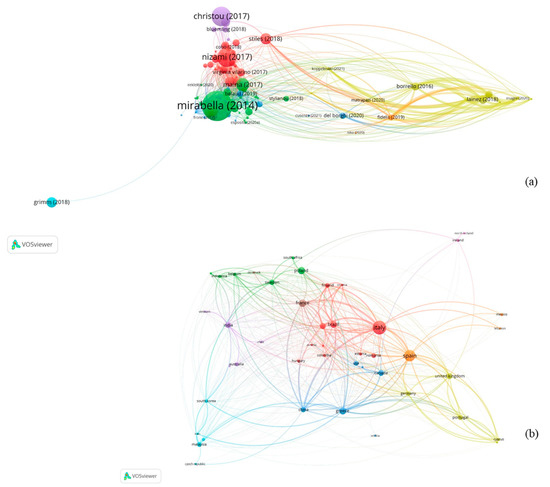
Figure 10.
Bibliographic coupling network visualisation map for (a) document (Minimum number of citations of a document: 1), and (b) countries (Minimum number of documents of a country: 1).
The document written by Mirabella et al. (2014) is the most cited. Mirabella (2014), Nizami (2017) and Christou (2017) are the three main circles in the network. The map reflects the situation showed in Table 3 of the Most important papers: the most cited publications are also those to which two works refer at the same time in their respective bibliographies.
Speaking of countries, when they are clustered together, it means that the authors from these countries share references. The most productive countries (Italy, Spain and the United Kingdom) are thus distributed: Italy is clustered together with Austria, Brazil, Colombia, Croatia, Estonia, Finland, Hungary, the Netherlands, Romania and Switzerland; Spain, Lebanon and Mexico are grouped in another cluster; the UK, Cyprus, Germany, Israel and Portugal compose another one. It is noteworthy that even if the countries composing a cluster have no closer affinities, they share references among the authors, and the relationship between the circular economy and the agri-food sector seems to be a common field of research and investigation all over the world.
3.2.5. Co-Citation
A co-citation link is a link between two items that are both cited by the same document [36]. In this representation, the items are grouped together based on the number of times they are cited together. Figure 11 shows the co-citation network for sources (a) and authors (b). Sources and authors with at least six citations were included. The dimension of the label represents the number of citations per each source and author; when a link exists among two circles, it indicates that they are co-cited by the same document.
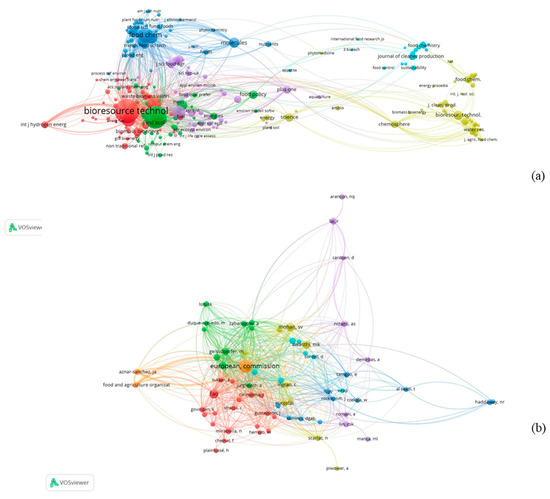
Figure 11.
Co-citation network visualisation map for (a) sources (Minimum number of citations of a source: 6) and (b) authors (Minimum number of citations of an author: 6).
The Journal of Cleaner Production belongs to the same cluster as Sustainability, the Journal of Environmental Management, Resources, Waste Management, Agronomy Research and others. Bioresource Technology is linked to Energy Policy, Green Chemistry, Renewable and Sustainable Energy Reviews, Waste and Biomass Valorization and others. In general, when journals are clustered together and they are co-cited, it means that they belong to the same field of research.
For the authors’ network, the European Commission is co-cited together with Food and Agriculture Organizations (FAO); Mirabella is clustered with Parfitt, Galanakis and Gustavsson. In wide terms, authors clustered together are cited together and they have more affinity in terms of research. Speaking of the relationship between the circular economy and the agri-food sector, the citation of the EU Commission and FAO together highlights the connection among these two bodies in terms of policies and international strategies. For the authors, each cluster can represent a specific topic of research. For instance, the red cluster to which belong Mirabella is devoted to food waste definition, quantification [16] and valorisation [20].
4. Discussion
This final section of the paper discusses the most important findings of the study, identifying the relevant trends in academic studies on circular economy in the agri-food sector. The main limitations are listed, providing the baseline for possible future lines of research.
Based on the literature review, it is possible to underline the fact that the circular economy is a concept of marked interest. This is proven by the fact that the initial research with less constrictions gave a total result of 1557 publications in Scopus and WoS, and it is experiencing a positive trend in publications, with an exponential increase of the documents in recent years. Despite this fact, the tie with the agricultural and agri-food sector is still not fully exploited. This result can also be deduced from the research areas investigated: there is a tendency to focus still on the environment and engineering (bioenergy, in particular), rather than economics (with the development of models designed to evaluate the feasibility and circularity of a production system) and agriculture. Circular economy represents a novel economic model, where the old linear “make-use-dispose” wants to be replaced by a circular approach based on the “3R” principles “reduction-reuse-recycling”. It is notable that the publications regarding policy and economics are few, as are the ones related to the consumer and their approach to the reuse and valorisation of wastes in food products.
From the literature and bibliometric analysis, Europe resulted as the most active in the research. However, circular economy only recently has become prominent among the European policy makers [53], drawing from the publication of the Circular Economy Action Plan in 2015 and the New Circular Economy Action Plan in 2020. In particular, Italy, Spain and The United Kingdom are the countries with the highest number of publications (by themselves, they represent the 36% of the total amount of documents). This result is in line with the recent political actions of the European Union in terms of green economy and ecological transition: the aim is to reach climate neutrality by 2050 [54] and reduce wastes up to 20% by 2030 [55]. Moreover, the farm-to-fork strategy is at the heart of the European Green Deal [56]. It addresses the challenges of sustainable food systems and reinforces the links between people and the environment. The strategy is also in line with the Commission’s agenda to achieve the United Nations’ Sustainable Development Goals (SDGs), in particular SDG 12 (Responsible Consumption and Production) [57].
A shift to a sustainable food system can bring environmental, health and social benefits. The link among the farm to fork strategy and the Circular Economy Action Plan is evident, as the European Commission takes action to promote sustainable production methods and circular business models in the agri-food sector. The transition to a circular and sustainable EU green economy provides business opportunities, for instance linked to making use of food waste [58]. To support these new strategies, the European Commission and the European Economic and Social Committee set up the European Circular Economy Stakeholder Platform (ECESP). ECESP is a joint initiative born to foster the transition towards a circular economy, bringing together stakeholders that are active in the field of the circular economy, following the actions included in the 2015 Circular Economy Action Plan [59].
In addition to the European policies, each Member State has a different approach to the circular economy, and it is not possible to find a common regulation followed by all. There is a great discrepancy as some have been implanting a circular model for several years, while others are only approaching it recently following the European example. The Netherlands is one of the most virtuous countries. The government aims to implement a circular model by 2050, and the ambition is to realise a 50% reduction in the use of primary raw materials by 2030 [60]. France put in place the Energy Transition Law for Green Growth project in 2015 and an ambitious roadmap for a circular economy in 2018. Recently, in February 2020, the so-called Anti-Waste Law for a Circular Economy promoted the management and prevention of waste production, the improvement of consumer information, the fight against squandering and the reuse of resources. This French act of law contains about 50 measures regarding obligations for the creation of producer responsibility, prohibitions on single-use plastics and to fight waste of food and non-food unsold products, new tools to better control and sanctions [61]. Italy is in the top positions in Europe in terms of the circular economy [62]. There is work in progress in the policies and regulations approved at national level. As a consequence of the issuance of the Law n. 221 of 28 December 2015, the so-called "Collegato Ambientale" and of other regulatory measures, the Italian government has put in place some actions aimed at promoting the circular economy (Decreto Ministeriale del 24 maggio 2016; Decreto Ministeriale del 26 maggio 2016; Decreto Ministeriale del 10 giugno 2016, n.140; Legge n. 166 del 19 agosto 2016; Decreto Ministeriale n.264 del 13 ottobre 2016; Decreto Ministeriale n. 266 del 29 dicembre 2016; Decreto Ministeriale del 15 febbraio 2017; Decreto Ministeriale del 20 aprile 2017). In 2017, the Bioeconomy Strategy [63] was approved. The Strategy offers a shared vision of the environmental, economic, social and international cooperation opportunities and challenges connected to the development of an Italian bioeconomy rooted in the territory. Moreover, the Italian Circular Economy Stakeholder Platform (ICESP), a mirror platform of ECESP, was created in 2018.
Even if it is not the most active in terms of research regarding the circular economy and the agri-food sector, China is the leading country in terms of effective implementation. Since 2003, the term “circular economy” became more frequent, and in 2004, the Central Economic Affairs Meeting decided to promote the circular economy as a long-term strategic task of Chinese economic development [64]. In 2008, the Circular Economy Promotion Law was promulgated to enforce the strong political commitment to circular economy. In China, five-year plans (FYP) are the most important government plans, and the circular economy became a leading aspect since the 11th FYP [65].
From the network visualization of co-authorship, authors from countries sharing aspects of relatedness, such as a similar language (Spain and Italy) or the geographical proximity (China and South Korea), had worked together. This can limit the research to separated cluster of problematics, while the networking and sharing of ideas should always be promoted.
The bibliometric analysis showed, through the co-occurrence map, the most important areas of research when debating about the development of a circular model in the agri-food supply chain. A series of concepts related to the environmental sustainability (such as impacts, climate change, greenhouse gas emissions), the production of bioenergy (renewable energy, biohydrogen production, anaerobic digestion), the preservation of soil (agricultural waste, phosphorus, fertilizer, manure) and the recovery of valuable components (antioxidant activity, polyphenols) develop around the central theme of circular economy.
A limitation of the study is its circumscription to the evaluation of the recovery and valorisation of waste, while the concept of circular economy in the agri-food sector can be broader and include several aspects of the supply chain. The themes are not fully exploited yet, and this is clear by the fact that most of the articles are written considering the possible use of food waste and by-products from a technological point of view and feasibility [22,66,67], while the economic feasibility is not always considered. This lack can be due to the substantial absence of a practical new economic model, based on indicators which can measure the circularity of a production system. The literature is full of examples of circular economy-based approaches, but only few cases investigate the whole value chain [68], generally omitting the practical application of the study on real complex situations. A winning approach could be the implementation of supply chains where the industrial symbiosis becomes the common paradigm [69,70]. The added value in this approach is related properly to the waste generation: the waste of some economic actors becomes a resource for other stakeholders, pursuing the integration of the three dimensions (environmental, social and economic) of the sustainable development [71]. In this way, trough the creation of Business Networks, different groups of companies can benefit in a different magnitude, each one sharing and receiving from the others [72].
The evaluation of circularity is at the base to understand the transition from the linear to the circular model [73]. In this sense, the European Commission developed a series of circular economy indicators to measure the circularity of the Member States [74]. The complex relationship among economic models, policies and circular economy should be investigated in future studies.
The overlay visualisation displayed the items on the basis of the period of publication. In recent years, the recovery and valorisation of valuable bioactive components [21,66,75] and the management of phosphorus to improve the soil characteristics in a sustainable way [76,77] became relevant in the scientific literature. In order to favour the recovery and valorisation of food waste, it is necessary to implement the current Waste Framework Directive [17]. This Directive lays down basic concepts and definitions related to waste management, including definitions of waste, recycling and recovery. It includes the definition of by-products and the end of waste criteria, which specifies when certain waste ceases the qualification of waste and becomes a product or a secondary raw material. It is relevant to underline that, currently, the EU has provided only three Regulations on iron, steel and aluminium scrap, glass cullet and copper scrap(Council Regulation (EU) No 333/2011 of 31 March 2011 establishing criteria determining when certain types of scrap metal cease to be waste under Directive 2008/98/EC of the European Parliament and of the Council; Commission Regulation (EU) No 1179/2012 of 10 December 2012 establishing criteria determining when glass cullet ceases to be waste under Directive 2008/98/EC of the European Parliament and of the Council; Commission Regulation (EU) No 715/2013 of 25 July 2013 establishing criteria determining when copper scrap ceases to be waste under Directive 2008/98/EC of the European Parliament and of the Council) The Italian government adopted the European Directive with the promulgation of other legislative acts on secondary solid fuels, bituminous conglomerates, wastes from absorbent hygiene products (PAP) and vulcanised rubber(Decreto 14 febbraio 2013, n. 22. Regolamento recante disciplina di cessazione della qualifica di rifiuto di determinate tipologia di combustibili secondari (CSS), ai sensi dell’articolo 184-ter, comma 2, del decreto legislativo 3 aprile 2006, n. 152, e successive modificazioni; Decreto 28 marzo 2018, n. 69. Regolamento recante disciplina della cessazione della qualifica di rifiuto di conglomerato bituminoso ai sensi dell’articolo 184-ter, comma 2 del decreto legislativo 3 aprile 2006, n. 152; Decreto 15 maggio 2019, n. 62. Regolamento recante disciplina della cessazione della qualifica di rifiuto da prodotti assorbenti per la persona (PAP), ai sensi dell’articolo 184-ter, comma 2, del decreto legislativo 3 aprile 2006, n. 152; Decreto 31 marzo 2020, n. 78. Regolamento recante disciplina della cessazione della qualifica di rifiuto della gomma vulcanizzata derivante da penumatici fuori uso, ai sensi dell’articolo 184-ter, del decreto legislativo 3 aprile 2006, n. 152).
It will be necessary for the future to promote end of waste criteria tailored for the agri-food sector, to harmonise the discrepancies among Member States and facilitate the re-use of wastewaters and production wastes from the food industry. Currently, the Waste Framework Directive reports the criteria for the end of waste status (article 6), and one of them refers to the existence of a market for the recovered waste. Therefore, the implementation of a market for the secondary raw materials and derived products is essential, and the consumer should be involved more in circularity practices [78] to understand if there is a real acceptance and purchasing intention for food obtained from by-products and wastes [79]. The objective of policy makers and academics should be the implementation of technological and business models and the elimination of barriers for the adoption of practices supporting a circularity system, devoted to a sustainable supply chain, from the producer to the consumer [80].
5. Conclusions
The aim of this work was to perform a literature review coupled with a bibliometric analysis, using VOSviewer software, on the circular economy model in the agri-food sector, with particular relevance to the re-use and valorisation of wastes and by-products. The search in Scopus and WoS platforms produced 125 documents to be analysed. This framework allowed us to analyse the past and current direction of circular economy studies in this field. The results of this study suggest that circular economy–agri-food linkage deserves much further investigation. The authors suggest that future study should investigate the policies and regulations involved in the improvement of the circularity. Industrial symbiosis could be a future field of work on which develop possible case studies for the implementation of a successful new economic model.
Author Contributions
The authors take part to the research work providing the following contributions: introduction, A.F.; materials and methods, G.C.; validation, D.B., G.C. and A.F.; software, G.C.; results, D.B. and G.C.; discussion, D.B., G.C. and A.F.; conclusion D.B., G.C. and A.F.; supervision, A.F.; funding acquisition, A.F. All authors have read and agreed to the published version of the manuscript.
Funding
The present research belongs to an innovative doctoral scholarship with industrial characterization, funded by the Marche Region (Italy) with the resources of the ROP Marche ESF 2014/2020, in favour of the Università Politecnica delle Marche (UNIVPM)—Department of Agricultural, Food and Environmental Sciences (D3A).
Institutional Review Board Statement
Not applicable.
Informed Consent Statement
Not applicable.
Data Availability Statement
Not applicable.
Acknowledgments
We thank all the members of the research team for their collaboration. Moreover, the authors would like to thank the anonymous reviewers for their valuable comments.
Conflicts of Interest
The authors declare no conflict of interest.
References
- Jurgilevich, A.; Birge, T.; Kentala-Lehtonen, J.; Korhonen-Kurki, K.; Pietikäinen, J.; Saikku, L.; Schösler, H. Transition towards circular economy in the food system. Sustainability 2016, 8, 69. [Google Scholar] [CrossRef] [Green Version]
- Ellen Macarthur Foundation. Towards a Circular Economy: Business Rationale for an Accelerated Transition. 2015. Available online: https://www.ellenmacarthurfoundation.org/assets/downloads/TCE_Ellen-MacArthur-Foundation_9-Dec-2015.pdf (accessed on 27 April 2021).
- Ghisellini, P.; Cialani, C.; Ulgiati, S. A review on circular economy: The expected transition to a balanced interplay of environmental and economic systems. J. Clean. Prod. 2016, 114, 11–32. [Google Scholar] [CrossRef]
- European Parliament. 2015. Available online: https://www.europarl.europa.eu/news/en/headlines/priorities/circular-economy/20151201STO05603/circular-economy-definition-importance-and-benefits (accessed on 13 May 2021).
- Kirchherr, J.; Reike, D.; Hekkert, M. Conceptualizing the circular economy: An analysis of 114 definitions. Resour. Conserv. Recy 2017, 127, 221–232. [Google Scholar] [CrossRef]
- Geissdoerfer, M.; Savaget, P.; Bocken, N.M.; Hultink, E.J. The Circular Economy—A new sustainability paradigm? J. Clean. Prod. 2017, 143, 757–768. [Google Scholar] [CrossRef] [Green Version]
- Korhonen, J.; Honkasalo, A.; Seppälä, J. Circular economy: The concept and its limitations. Ecol. Econ. 2018, 143, 37–46. [Google Scholar] [CrossRef]
- European Commission. Closing the Loop: An EU Action Plan for the Circular Economy; European Commission: Brussels, Belgium, 2015; Available online: https://eur-lex.europa.eu/resource.html?uri=cellar:8a8ef5e8-99a0-11e5-b3b7-01aa75ed71a1.0012.02/DOC_1&format=PDF (accessed on 27 April 2021).
- European Commission. Report on the Implementation of the Circular Economy Action Plan; European Commission: Brussels, Belgium, 2019; Available online: https://eur-lex.europa.eu/legal-content/EN/TXT/PDF/?uri=CELEX:52019DC0190&from=EN (accessed on 27 April 2021).
- European Commission. Circular Economy Action Plan for a Cleaner and More Competitive Europe; European Commission: Brussels, Belgium, 2020; Available online: https://ec.europa.eu/environment/pdf/circular-economy/new_circular_economy_action_plan.pdf (accessed on 27 April 2021).
- Cristóbal, J.; Castellani, V.; Manfredi, S.; Sala, S. Prioritizing and optimizing sustainable measures for food waste prevention and management. Waste Manag. 2018, 72, 3–16. [Google Scholar] [CrossRef]
- Stenmarck, Å.; Jensen, C.; Quested, T.; Moates, G. Estimates of European Food Waste Levels; IVL Swedish Environmental Research Institute: Stockholm, Sweden, 2016. [Google Scholar]
- Finco, A.; Bentivoglio, D.; Bucci, G. Lessons of Innovation in the Agrifood Sector: Drivers of Innovativeness Performances. Econ. Agro Aliment. Food Econ. 2018, 20, 181–192. [Google Scholar] [CrossRef]
- Eurostat. 2021. Available online: https://ec.europa.eu/eurostat/statistics-explained/index.php?title=Waste_statistics (accessed on 13 May 2021).
- FAO. Global Food Losses and Food Waste. In Extent, Causes and Prevention; FAO: Rome, Italy, 2011. [Google Scholar]
- Parfitt, J.; Barthel, M.; Macnaughton, S. Food waste within food supply chains: Quantification and potential for change to 2050. Philos. Trans. R. Soc. B Biol. Sci. 2010, 365, 3065–3081. [Google Scholar] [CrossRef] [PubMed] [Green Version]
- European Commission. Directive 2008/98/EC of 19 November 2008 on Waste and Repealing Certain Directives; European Commission: Brussels, Belgium, 2008; Available online: https://eur-lex.europa.eu/legal-content/EN/TXT/PDF/?uri=CELEX:32008L0098&from=EN (accessed on 11 May 2021).
- Papargyropoulou, E.; Lozano, R.; Steinberger, J.K.; Wright, N.; Ujang, Z.B. The food waste hierarchy as a framework for the management of food surplus and food waste. J. Clean. Prod. 2014, 76, 106–115. [Google Scholar] [CrossRef]
- Girotto, F.; Alibardi, L.; Cossu, R. Food waste generation and industrial uses: A review. Waste Manag. 2015, 45, 32–41. [Google Scholar] [CrossRef] [PubMed]
- Galanakis, C.M. Recovery of high added-value components from food wastes: Conventional, emerging technologies and commercialized applications. Trends Food Sci. Technol. 2012, 26, 68–87. [Google Scholar] [CrossRef]
- Caruso, G.; Floris, R.; Serangeli, C.; Di Paola, L. Fishery wastes as a yet undiscovered treasure from the sea: Biomolecules sources, extraction methods and valorization. Mar. Drugs 2020, 18, 622. [Google Scholar] [CrossRef] [PubMed]
- Hussain, S.; Jõudu, I.; Bhat, R. Dietary fiber from underutilized plant resources-A positive approach for valorization of fruit and vegetable wastes. Sustainablity 2020, 12, 5401. [Google Scholar] [CrossRef]
- Plainfossé, H.; Trinel, M.; Verger-Dubois, G.; Azoulay, S.; Burger, P.; Fernandez, X. Valorisation of Ribes nigrum L. Pomace, an Agri-Food By-Product to Design a New Cosmetic Active. Cosmetics 2020, 7, 56. [Google Scholar] [CrossRef]
- Osorio, L.L.D.R.; Flórez-López, E.; Grande-Tovar, C.D. The Potential of Selected Agri-Food Loss and Waste to Contribute to a Circular Economy: Applications in the Food, Cosmetic and Pharmaceutical Industries. Molecules 2021, 26, 515. [Google Scholar] [CrossRef]
- Matos, J.S.; Barberino, A.T.M.S.; de Araujo, L.P.; Lôbo, I.P.; de Almeida Neto, J.A. Potentials and Limitations of the Bioconversion of Animal Manure Using Fly Larvae. Waste Biomass Valori. 2020, 12, 3497–3520. [Google Scholar] [CrossRef]
- Derler, H.; Lienhard, A.; Berner, S.; Grasser, M.; Posch, A.; Rehorska, R. Use Them for What They Are Good at: Mealworms in Circular Food Systems. Insects 2021, 12, 40. [Google Scholar] [CrossRef]
- Lahlou, F.-Z.; Mackey, H.R.; Al-Ansari, T. Wastewater reuse for livestock feed irrigation as a sustainable practice: A so-cio-environmental-economic review. J. Clean. Prod. 2021, 294, 126331. [Google Scholar] [CrossRef]
- Renai, L.; Tozzi, F.; Scordo, C.V.; Giordani, E.; Bruzzoniti, M.C.; Fibbi, D.; Mandi, L.; Ouazzani, N.; Del Bubba, M. Productivity and nutritional and nutraceutical value of strawberry fruits (Fragaria x ananassa Duch.) cultivated under irrigation with treated wastewaters. J. Sci. Food Agric. 2021, 101, 1239–1246. [Google Scholar] [CrossRef]
- Vaneeckhaute, C.; Styles, D.; Prade, T.; Adams, P.; Thelin, G.; Rodhe, L.; Gunnarsson, I.; D’Hertefeldt, T. Closing nutrient loops through decentralized anaerobic digestion of organic residues in agricultural regions: A multi-dimensional sustainability assessment. Resour. Conserv. Recycl. 2018, 136, 110–117. [Google Scholar] [CrossRef] [Green Version]
- Rekleitis, G.; Haralambous, K.J.; Loizidou, M.; Aravossis, K. Utilization of agricultural and livestock waste in anaerobic digestion (AD): Applying the biorefinery concept in a circular economy. Energies 2020, 13, 4428. [Google Scholar] [CrossRef]
- Di Bitonto, L.; Reynel-Ávila, H.E.; Mendoza-Castillo, D.I.; Bonilla-Petriciolet, A.; Pastore, C. Residual Mexican biomasses for bioenergy and fine chemical production: Correlation between composition and specific applications. Biomass Convers. Biorefin. 2021, 11, 619–631. [Google Scholar] [CrossRef]
- Camón Luis, E.; Celma, D. Circular Economy. A Review and Bibliometric Analysis. Sustainability 2020, 12, 6381. [Google Scholar] [CrossRef]
- Do, Q.; Ramudhin, A.; Mishra, N.; Wulandhari, I.; Lallwani, C.; Li, D. A systematic review of food loss and waste for the circular economy. In Proceedings of the 24th International Symposium on Logistics on “Supply Chain Networks vs Platforms: Innovations, Challenges and Opportunities”, Würzburg, Germany, 14–17 July 2019; pp. 436–462. [Google Scholar]
- González-Torres, T.; Rodríguez-Sánchez, J.-L.; Pelechano-Barahona, E.; García-Muiña, F.E. A Systematic Review of Research on Sustainability in Mergers and Acquisitions. Sustainability 2020, 12, 513. [Google Scholar] [CrossRef] [Green Version]
- Martinho, V.D.; Mourão, P.R. Circular Economy and Economic Development in the European Union: A Review and Bibliometric Analysis. Sustainability 2020, 12, 7767. [Google Scholar] [CrossRef]
- Van Eck, N.J.; Waltman, L. VOSviewer Manual. 2020. Available online: https://www.vosviewer.com/documentation/Manual_VOSviewer_1.6.16.pdf (accessed on 17 February 2021).
- Hernández-Rosas, F.; Figueroa-Rodríguez, K.A.; García-Pacheco, L.A.; Velasco-Velasco, J.; Sangerman-Jarquín, D.M. Microorganisms and Biological Pest Control: An Analysis Based on a Bibliometric Review. Agronomy 2020, 10, 1808. [Google Scholar] [CrossRef]
- European Commission. Report on the Implementation of the Circular Economy Action Plan; European Commission: Brussels, Belgium, 2017; Available online: https://eur-lex.europa.eu/resource.html?uri=cellar:391fd22b-e3ae-11e6-ad7c-01aa75ed71a1.0001.02/DOC_1&format=PDF (accessed on 12 April 2021).
- Feng, K.; Lam, C.Y. An Overview of Circular Economy in China: How the Current Challenges Shape the Plans for the Future. Chin. Econ. 2021, 1–17. [Google Scholar] [CrossRef]
- Muscio, A.; Sisto, R. Are Agri-Food Systems Really Switching to a Circular Economy Model? Implications for European Research and Innovation Policy. Sustain. J. Rec. 2020, 12, 5554. [Google Scholar] [CrossRef]
- Mirabella, N.; Castellani, V.; Sala, S. Current options for the valorization of food manufacturing waste: A review. J. Clean. Prod. 2014, 65, 28–41. [Google Scholar] [CrossRef] [Green Version]
- Christou, A.; Agüera, A.; Bayona, J.M.; Cytryn, E.; Fotopoulos, V.; Lambropoulou, D.; Manaia, C.M.; Michael, C.; Revitt, M.; Schröder, P. The potential implications of reclaimed wastewater reuse for irrigation on the agricultural environment: The knowns and unknowns of the fate of antibiotics and antibiotic resistant bacteria and resistance genes—A review. Water Res. 2017, 123, 448–467. [Google Scholar] [CrossRef] [Green Version]
- Nizami, A.S.; Rehan, M.; Waqas, M.; Naqvi, M.; Ouda, O.K.M.; Shahzad, K.; Miandad, R.; Khan, M.Z.; Syamsiro, M.; Ismail, I.M.; et al. Waste biorefineries: Enabling circular economies in developing countries. Bioresour. Technol. 2017, 241, 1101–1117. [Google Scholar] [CrossRef]
- Stiles, W.A.V.; Styles, D.; Chapman, S.P.; Esteves, S.; Bywater, A.; Melville, L.; Silkina, A.; Lupatsch, I.; Grünewald, C.F.; Lovitt, R.; et al. Using microalgae in the circular economy to valorise anaerobic digestate: Challenges and opportunities. Bioresour. Technol. 2018, 267, 732–742. [Google Scholar] [CrossRef] [Green Version]
- Markou, G.; Wang, L.; Ye, J.F.; Unc, A. Using agro-industrial wastes for the cultivation of microalgae and duckweeds: Contamination risks and biomass safety concerns. Biotechnol. Adv. 2018, 36, 1238–1254. [Google Scholar] [CrossRef]
- Maina, S.; Kachrimanidou, V.; Koutinas, A. A roadmap towards a circular and sustainable bioeconomy through waste valorization. Curr. Opin. Green Sustain. Chem. 2017, 8, 18–23. [Google Scholar] [CrossRef]
- Grimm, D.; Wösten, H.A.B. Mushroom cultivation in the circular economy. Appl. Microbiol. Biotechnol. 2018, 102, 7795–7803. [Google Scholar] [CrossRef] [PubMed] [Green Version]
- Hamelin, L.; Borzęcka, M.; Kozak, M.; Pudełko, R. A spatial approach to bioeconomy: Quantifying the residual biomass potential in the EU-27. Renew. Sustain. Energy Rev. 2019, 100, 127–142. [Google Scholar] [CrossRef]
- Riding, M.J.; Herbert, B.M.J.; Ricketts, L.; Dodd, I.; Ostle, N.; Semple, K.T. Harmonising conflicts between science, regulation, perception and environmental impact: The case of soil conditioners from bioenergy. Environ. Int. 2015, 75C, 52–67. [Google Scholar] [CrossRef] [PubMed]
- Pagotto, M.; Halog, A. Towards a Circular Economy in Australian Agri-food Industry An Application of Input-Output Oriented Approaches for Analyzing Resource Efficiency and Competitiveness Potential. J. Ind. Ecol. 2015, 20, 1176–1186. [Google Scholar] [CrossRef]
- Zucchella, A.; Previtali, P. Circular business models for sustainable development: A “waste is food” restorative ecosystem. Bus. Strateg. Environ. 2018, 1–12. [Google Scholar] [CrossRef]
- Hamam, M.; Chinnici, G.; Di Vita, G.; Pappalardo, G.; Pecorino, B.; Maesano, G.; D’Amico, M. Circular Economy Models in Agro-Food Systems: A Review. Sustainability 2021, 13, 3453. [Google Scholar] [CrossRef]
- McDowall, W.; Geng, Y.; Huang, B.; Barteková, E.; Bleischwitz, R.; Türkeli, S.; Kemp, R.; Doménech, T. Circular economy policies in China and Europe. J. Ind. Ecol. 2017, 21, 651–661. [Google Scholar] [CrossRef] [Green Version]
- European Commission. The European Green Deal; European Commission: Brussels, Belgium, 2019; Available online: https://eur-lex.europa.eu/resource.html?uri=cellar:b828d165-1c22-11ea-8c1f-01aa75ed71a1.0002.02/DOC_1&format=PDF (accessed on 12 May 2021).
- Condamine, P. Can the European Union Support Waste Prevention without a Proper Legislation? 2020. Available online: https://zerowasteeurope.eu/library/the-case-for-an-integrated-waste-prevention-framework/ (accessed on 10 May 2021).
- Garske, B.; Heyl, K.; Ekardt, F.; Weber, L.M.; Gradzka, W. Challenges of food waste governance: An assessment of European legislation on food waste and recommendations for improvement by economic instruments. Land 2020, 9, 231. [Google Scholar] [CrossRef]
- Union Nations. Transforming Our World: The 2030 Agenda for Sustainable Development. New York, 2015. Available online: http://www.un.org/en/ga/search/view_doc.asp?symbol=A/RES/70/1 (accessed on 27 April 2021).
- European Commission. Farm to Fork Strategy for a Fairy, Healthy and Environmentally-Friendly Food System; European Commission: Brussels, Belgium, 2020; Available online: https://eur-lex.europa.eu/resource.html?uri=cellar:ea0f9f73-9ab2-11ea-9d2d-01aa75ed71a1.0001.02/DOC_1&format=PDF (accessed on 10 May 2021).
- Vecchio, P.D.; Passiante, G.; Barberio, G.; Innella, C. Digital innovation ecosystems for circular economy: The case of ICESP, the Italian circular economy stakeholder platform. Int. J. Innov. Technol. Manag. 2020, 18, 2050053. [Google Scholar] [CrossRef]
- Governement of Netherlands. A Circular Economy in the Netherlands by 2050. 2016. Available online: https://www.government.nl/documents/policy-notes/2016/09/14/a-circular-economy-in-the-netherlands-by-2050 (accessed on 10 May 2021).
- Ministère de la Transition Ecologique. The Anti-Waste Law in the Daily Lives of the French People: What Does that Mean in Practice? 2020. Available online: https://circulareconomy.europa.eu/platform/sites/default/files/anti-waste_law_in_the_daily_lives_of_french_people.pdf (accessed on 10 May 2021).
- Circular Economy Network; ENEA. Rapporto Sull’economia Circolare in Italia. 2020. Available online: https://circulareconomynetwork.it/wp-content/uploads/2020/04/Rapporto-sulleconomia-circolare-in-Italia-2020_r04.pdf (accessed on 27 April 2021).
- Presidenza del Consiglio dei Ministri. Strategia Italiana per la Bioeconomia. 2017. Available online: https://www.agenziacoesione.gov.it/wp-content/uploads/2019/06/bioeconomia_eng.pdf (accessed on 27 April 2021).
- Yong, R. The circular economy in China. J. Mater. Cycles Waste Manag. 2007, 9, 121–129. [Google Scholar] [CrossRef]
- Zhao, Y. China in transition towards a circular economy: From policy to practice. J. Prop. Plan. Environ. Law 2020, 12, 187–202. [Google Scholar] [CrossRef]
- Fidelis, M.; de Moura, C.; Junior, T.K.; Pap, N.; Mattila, P.; Mäkinen, S.; Putnik, P.; Kovačević, D.B.; Tian, Y.; Yang, B. Granato Fruit Seeds as Sources of Bioactive Compounds: Sustainable Production of High Value-Added Ingredients from By-Products within Circular Economy. Molecules 2019, 24, 3854. [Google Scholar] [CrossRef] [PubMed] [Green Version]
- Mirpoor, S.F.; Giosafatto, C.V.L.; Porta, R. Biorefining of seed oil cakes as industrial co-streams for production of innovative bioplastics. A review. Trends Food Sci. Technol. 2021, 109, 259–270. [Google Scholar] [CrossRef]
- Van Keulen, M.; Kirchherr, J. The implementation of the Circular Economy: Barriers and enablers in the coffee value chain. J. Clean. Prod. 2021, 281, 125033. [Google Scholar] [CrossRef]
- Domenech, T.; Bleischwitz, R.; Doranova, A.; Panayotopoulos, D.; Roman, L. Mapping Industrial Symbiosis Development in Europe: Typologies of networks, characteristics, performance and contribution to the Circular Economy. Resour. Conserv. Recycl. 2019, 141, 76–98. [Google Scholar] [CrossRef]
- Frone, D.F.; Frone, S. Circular economy in Romania: An industrial synergy in the agri-food sector. Sci. Pap. Ser. Manag. Econ. Eng. Agric. Rural Dev. 2017, 17, 9. [Google Scholar]
- Vinci, G.; Musarra, M.; Esposito, A.; D’Ascenzo, F. Industrial symbiosis: A sustainable approach for territorial development through the reuse of biomass. In Waste and Waste Management; Organic Waste: Management Strategies, Environmental Impact and Emerging Regulations; Collins, M., Ed.; Nova Science Publishers: New York, NY, USA, 2017; pp. 141–160. [Google Scholar]
- Florencio de Souza, F.; Bigarelli Ferreira, M.; Valélia Saraceni, A.; Mendes Betim, L.; Lucas Pereira, T.; Petter, R.R.H.; Negri Pagani, R.; Mauricio Martins de Resende, L.; Pontes, J.; Moro Piekarski, C. Temporal comparative analysis of industrial symbiosis in a business network: Opportunities of circular economy. Sustainability 2020, 12, 1832. [Google Scholar] [CrossRef] [Green Version]
- Saidani, M.; Yannou, B.; Leroy, Y.; Cluzel, F.; Kendall, A.; Saidani, M.; Yannou, B.; Leroy, Y.; Cluzel, F.; Kendall, A. A taxonomy of circular economy indicators. J. Clean. Prod. 2019, 207, 542–559. [Google Scholar] [CrossRef] [Green Version]
- Eurostat. Available online: https://ec.europa.eu/eurostat/web/circular-economy/indicators (accessed on 27 April 2021).
- Markhali, F.S.; Teixeira, J.A.; Rocha, C.M.R. Olive Tree Leaves—A Source of Valuable Active Compounds. Processes 2020, 8, 1177. [Google Scholar] [CrossRef]
- Barquet, K.; Järnberg, L.; Rosemarin, A.; Macura, B. Identifying barriers and opportunities for a circular phosphorus economy in the Baltic Sea region. Water Res. 2020, 171, 115433. [Google Scholar] [CrossRef] [PubMed]
- Rahimpour Golroudbary, S.; El Wali, M.; Kraslawski, A. Rationality of using phosphorus primary and secondary sources in circular economy: Game-theory-based analysis. Environ. Sci. Policy 2020, 106, 166–176. [Google Scholar] [CrossRef]
- Borrello, M.; Caracciolo, F.; Lombardi, A.; Pascucci, S.; Cembalo, L. Consumers’ Perspective on Circular Economy Strategy for Reducing Food Waste. Sustainability 2017, 9, 141. [Google Scholar] [CrossRef] [Green Version]
- Coderoni, S.; Perito, M.A. Sustainable consumption in the circular economy. An analysis of consumers’ purchase intentions for waste-to-value food. J. Clean. Prod. 2020, 252, 119870. [Google Scholar] [CrossRef]
- Cembalo, L.; Borrello, M.; De Luca, A.I.; Giannoccaro, G.; D’Amico, M. Transitioning agri-food systems into circular economy trajectories. Sustain. Dev. Circ. Econ. 2021, 199–218. [Google Scholar] [CrossRef]
Publisher’s Note: MDPI stays neutral with regard to jurisdictional claims in published maps and institutional affiliations. |
© 2021 by the authors. Licensee MDPI, Basel, Switzerland. This article is an open access article distributed under the terms and conditions of the Creative Commons Attribution (CC BY) license (https://creativecommons.org/licenses/by/4.0/).